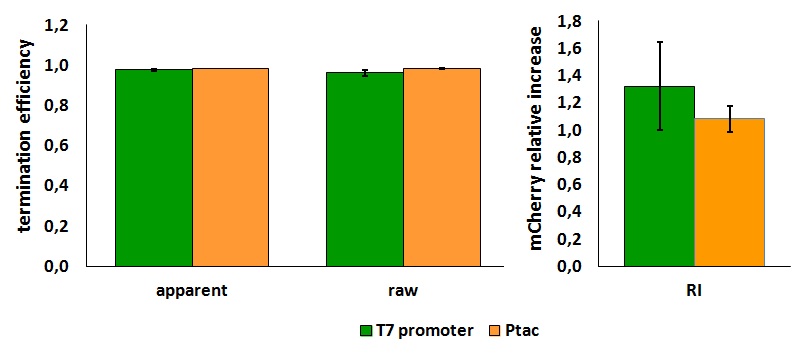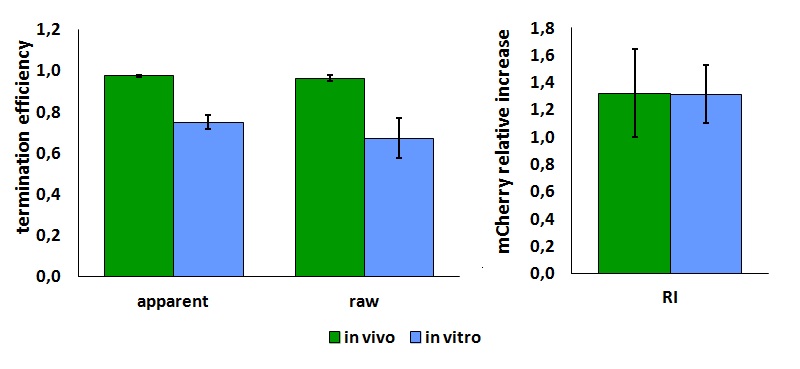Part:BBa_B0010:Experience
This experience page is provided so that any user may enter their experience using this part.
Please enter
how you used this part and how it worked out.
Applications of BBa_B0010
- PCR Problems: Using primers VR and VF2 to PCR B0010 results in excess bands. VR can anneal to B0010, resulting in shorter bands than expected. A full description of the problem is available here.
User Reviews
UNIQ56c1eb6bf884ddf8-partinfo-00000000-QINU
|
•••••
iGEM Athens 2019 |
We attempted to measure the efficiency of the terminator by cloning it into the pSB1A10 plasmid and culturing the bacteria for 24 hours (37 degrees Celsius, 200RPM, 0.1% arabinose, 100 µg/mL ampicillin). The culture was pelleted and the pellet was resuspended in 1mL of 1X PBS. From that, 10 μL were diluted in 990 mL of 1X PBS to yield approximately 5 million cells. For FACS, we used BD FACSCanto™ II. During FACS, a low flow rate was used. We used the following excitation and emission wavelengths: GFP: excitation = 488 nm, emission = 510 nm ; RFP: excitation = 488 nm, emission = 584 nm. The efficiency is measured through the following formula: Termination efficiency = 1 -{[RFPterm/GFPterm]/[(RFPcontrol/GFPcontrol)mean]}. This measurement showed that the efficiency of the terminator is 0%. We also measured the terminator efficiency using the GFP+RFP+ population and the formula: Terminator efficiency = 1 - (Intensity of GFP+RFP+term/Intensity of GFP+RFP+control). This measurement showed that the terminator efficiency of the terminator is 7%. |
|
Antiquity |
This review comes from the old result system and indicates that this part did not work in some test. |
|
Trento iGEM team 2012 |
This part was successfully extracted from the distribution kits 2012 and 2011. However, it was not confirmed by restriction digestion nor PCR. We were able to amplify it by PCR from BBa_E0840, that contains the double terminator BBa_B0015, subcloned it into pSB1C3 and confirmed by sequencing. We re-deposited rrnBT1 terminator well-characterized and well-functioning as BBa_K731722.
TABLE 1. Standard and modified excitation and emission wavelengths. We adopted these modified excitation and emission wavelengths for both in vivo and iv vitro measurements.
The parameters used to analyze the data are: apparent termination efficiency, calculated with the equation found in literature Nojima, raw termination efficiency, that does not consider the mCherry contribution relative increase in the upstream gene expression,
-Vs is the A206K Venus peak’s intensity of the construct with the terminator of interest inserted in the prefix-suffix linker -Vc is the A206K Venus peak’s intensity of the control construct without intervening terminator -Cs is the mCherry peak’s intensity of the construct with the terminator inserted -Cc is the mCherry peak’s intensity of the control construct
Our experiments exploited an E. coli lysogen strain carrying T7 RNA polymerase and lacIq. Additionally, the cells, i.e. E. coli BL21(DE3) pLysS, also contained a plasmid encoding T7 lysozyme and chloramphenicol resistance. T7 lysozyme is a natural inhibitor of T7 RNA polymerase activity, thus reducing background expression of the target genes. The T7 RNA polymerase is behind a lacUV5 promoter.
FIGURE 1. E.coli terminator's effect on protein expression with two different RNA polymerases In vitro measurements: We performed the in vitro analysis only with the T7 RNA polymerase. FIGURE 2. E.coli terminator's effect on in vitro protein synthesis with the T7 RNA polymerases We submitted also this Part inside both BBa_K731700 (T7 promoter backbone) and BBa_K731710 (tac promoter backbone) as, respecitively, BBa_K731701 and BBa_K731702. We hope that this could be helpful for anyone who want to verify and further delve into our results. More information can be found in the iGEM Trento 2012 wiki page. References<biblio>
</biblio> |
UNIQ56c1eb6bf884ddf8-partinfo-00000005-QINU

 1 Registry Star
1 Registry Star






